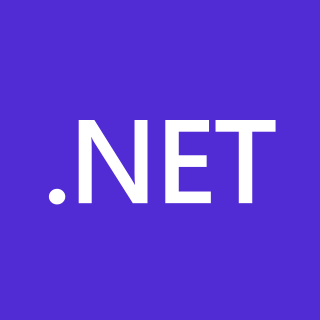ASP.NET is a server-side web-application framework designed for web development to produce dynamic web pages. It was developed by Microsoft to allow programmers to build dynamic web sites, applications and services. The name stands for Active Server Pages Network Enabled Technologies.

Windows Forms (WinForms) is a free and open-source graphical (GUI) class library included as a part of Microsoft .NET, .NET Framework or Mono, providing a platform to write client applications for desktop, laptop, and tablet PCs. While it is seen as a replacement for the earlier and more complex C++ based Microsoft Foundation Class Library, it does not offer a comparable paradigm and only acts as a platform for the user interface tier in a multi-tier solution.
Windows Presentation Foundation (WPF) is a free and open-source user interface framework for Windows-based desktop applications. WPF applications are based in .NET, and are primarily developed using C# and XAML.
The Microsoft Enterprise Library is a set of tools and programming libraries for the Microsoft .NET Framework. It provides APIs to facilitate proven practices in core areas of programming including data access, logging, exception handling and others. Enterprise Library is provided as pluggable binaries and source code, which can be freely used and customized by developers for their own purposes. It also ships with test cases and quickstarts.
QF-Test from Quality First Software is a cross-platform software tool for automated testing of programs via the graphical user interface. The program is specialized on cross-browser test automation of static and dynamic web-based applications. Version 4.1 added support for MacOS and the Apple Safari and Microsoft Edge browsers via the Selenium WebDriver. RESTful web service testing. From version 5.0, Windows applications can also be tested and modern C++ applications. Version 5.3 added support for the Chrome DevTools protocol, which allows browsers to be controlled using CDP drivers.

Ranorex Studio is a GUI test automation framework provided by Ranorex GmbH, a software development company. The framework is used for the testing of desktop, web-based and mobile applications.

Microsoft Silverlight is a discontinued application framework designed for writing and running rich internet applications, similar to Adobe's runtime, Adobe Flash. While early versions of Silverlight focused on streaming media, later versions supported multimedia, graphics, and animation, and gave support to developers for CLI languages and development tools. Silverlight was one of the two application development platforms for Windows Phone, but web pages using Silverlight did not run on the Windows Phone or Windows Mobile versions of Internet Explorer, as there was no Silverlight plugin for Internet Explorer on those platforms.
MIX was a Microsoft conference held annually for Web developers and designers at which Microsoft showcased upcoming web technologies. The conference was held each spring at the Venetian Hotel in Las Vegas. Unlike many of Microsoft's technical conference, MIX has been promoted more heavily to designers by inviting popular speakers from other popular web design conferences, such as SXSW, and has sponsored a CSS design contest each year to promote the conference. Microsoft has also used this conference as an opportunity to promote new web design and development tools such as Silverlight and Microsoft Expression Studio.

iMacros is a browser-based application for macro recording, editing and playback for web automation and testing. It is provided as a standalone application and extension for Mozilla Firefox, Google Chrome, and Internet Explorer web browsers. Developed by iOpus/Ipswitch, It adds record and replay functionality similar to that found in web testing and form filler software. The macros can be combined and controlled via JavaScript. Demo macros and JavaScript code examples are included with the software. Running strictly JavaScript-based macros was removed in later versions of iMacros browser extensions. However, users can use alternative browser like Pale Moon, based on older versions of Mozilla Firefox to use JavaScript files for web-based automated testing with Moon Tester Tool.
ASP.NET MVC is a web application framework developed by Microsoft that implements the model–view–controller (MVC) pattern. It is no longer in active development. It is open-source software, apart from the ASP.NET Web Forms component, which is proprietary.

Visual Studio is an integrated development environment (IDE) developed by Microsoft. It is used to develop computer programs including websites, web apps, web services and mobile apps. Visual Studio uses Microsoft software development platforms including Windows API, Windows Forms, Windows Presentation Foundation (WPF), Microsoft Store and Microsoft Silverlight. It can produce both native code and managed code.

TestComplete is a functional automated testing platform developed by SmartBear Software. TestComplete gives testers the ability to create automated tests for Microsoft Windows, Web, Android, and iOS applications. Tests can be recorded, scripted or manually created with keyword driven operations and used for automated playback and error logging.
MapDotNet is a suite of geographic information system (GIS) software products developed by ISC that run on Microsoft Windows. The GIS software competes with ESRI and MapInfo GIS products. MapDotNet UX is the latest generation and consists of a set of WCF web services for rendering map images and tiles and for performing spatial analysis and editing. UX includes an SDK for developing rich interactive mapping applications on Microsoft Silverlight, Windows Presentation Foundation and HTML5. MapDotNet UX also includes an Extract, Transform & Load (ETL), map design and tile cache creation tool called Studio modeled after Microsoft's Expression series of products. The MapDotNet UX renderer is built on WPF and consumes spatial data from multiple sources including Shapefiles, PostGIS, ArcSDE, Oracle Spatial, SQL Azure, SQL Server 2008 R2 and SQL Server 2012.
Model–view–viewmodel (MVVM) is an architectural pattern in computer software that facilitates the separation of the development of a graphical user interface —be it via a markup language or GUI code—from the development of the business logic or back-end logic such that the view is not dependent upon any specific model platform.

The .NET Framework is a proprietary software framework developed by Microsoft that runs primarily on Microsoft Windows. It was the predominant implementation of the Common Language Infrastructure (CLI) until being superseded by the cross-platform .NET project. It includes a large class library called Framework Class Library (FCL) and provides language interoperability across several programming languages. Programs written for .NET Framework execute in a software environment named the Common Language Runtime (CLR). The CLR is an application virtual machine that provides services such as security, memory management, and exception handling. As such, computer code written using .NET Framework is called "managed code". FCL and CLR together constitute the .NET Framework.

Mono is a free and open-source software framework that aims to run software made for the .NET Framework on Linux and other OSes. Originally by Ximian which was acquired by Novell, it was later developed by Xamarin which was acquired by Microsoft. In August 2024, Microsoft transferred ownership of Mono to WineHQ.

Telerik AD is a Bulgarian company offering software tools for web, mobile, desktop application development, tools and subscription services for cross-platform application development. Founded in 2002 as a company focused on .NET development tools, Telerik now also sells a platform for web, hybrid and native app development.

Katalon Platform is an automation testing software tool developed by Katalon, Inc. The software is built on top of the open-source automation frameworks Selenium, Appium with a specialized IDE interface for web, API, mobile and desktop application testing. Its initial release for internal use was in January 2015. Its first public release was in September 2016. In 2018, the software acquired 9% of market penetration for UI test automation, according to The State of Testing 2018 Report by SmartBear.
OpenSilver is an open-source framework designed to facilitate the development of rich internet applications (RIAs) using C# and XAML. It was developed as a successor to Microsoft Silverlight, enabling developers to migrate existing Silverlight applications to the web without rewriting their codebase. This framework is built on current web standards, including HTML5, CSS3, and WebAssembly, ensuring broad compatibility across modern web browsers regardless of the operating system without requiring plugins.










